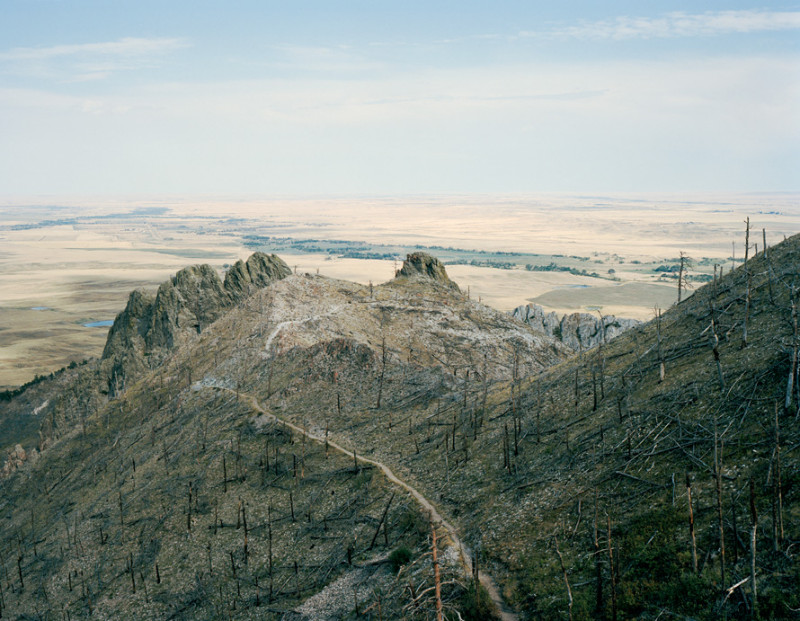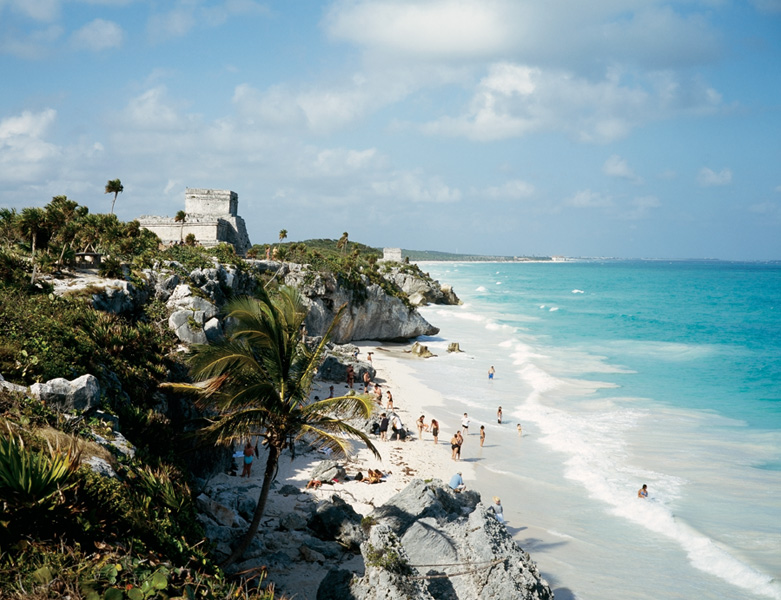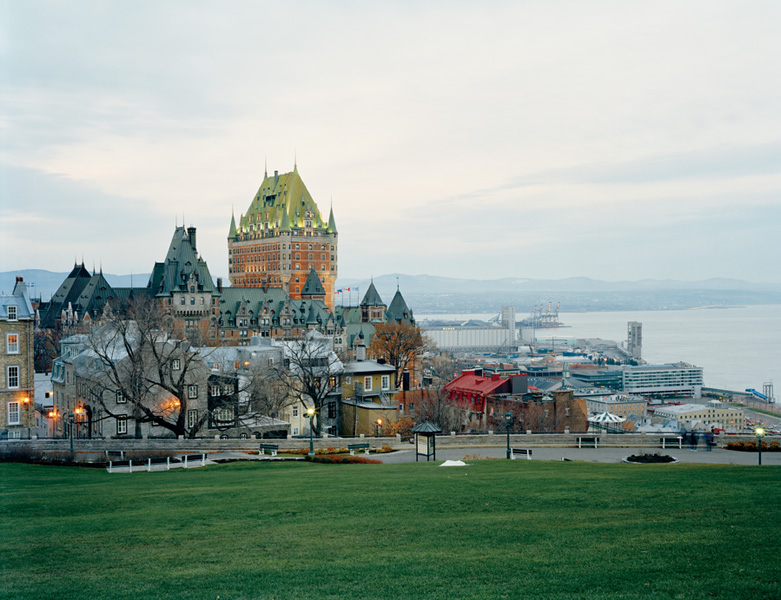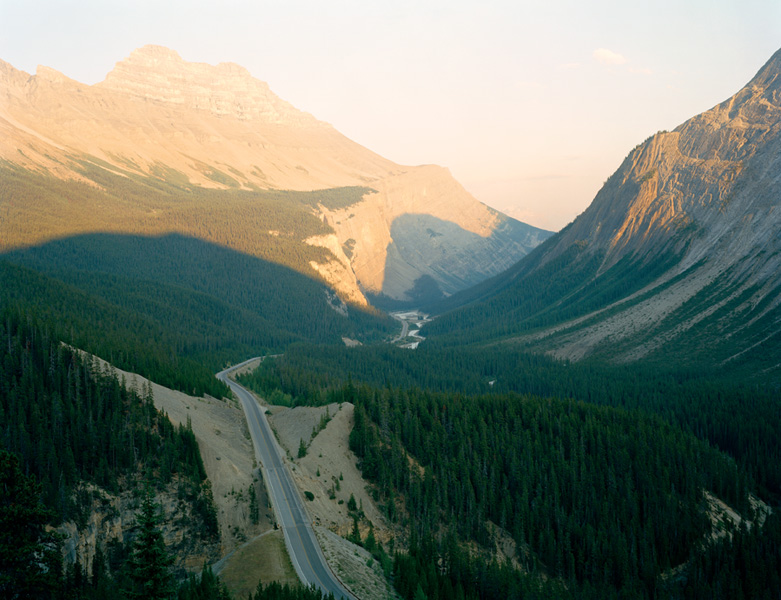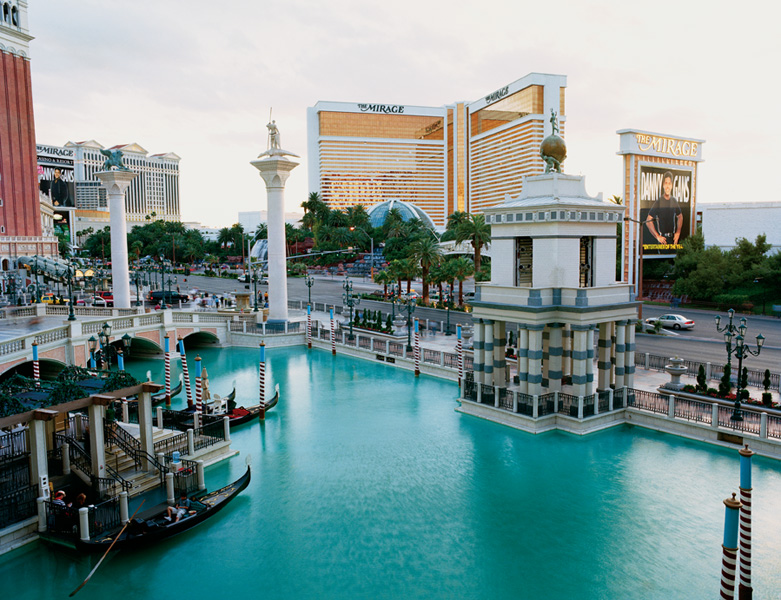[Fall 2007]
Popular sites and tourism fascinate Jessica Auer. She has produced a series of photographic works that were shot in North and South America in which landscapes and architecture have been preserved, renovated, altered, or built from scratch for the benefit of tourism. Through novel perspectives and intriguing details, she invites viewers to appreciate these sites while understanding the importance of their history, cultural authenticity, and role in collective memory. Through her works, Auer offers an opportunity to reflect on and participate in the use of these sites.
by Michelle Kasprzak
“The scene beckons you in, but just so far. This is comforting. You don’t have to go there; no need to climb that mountain, struggle down that slope, get muddy shoes on that trail, stand in the rain for long. The average tourist probably spends a few minutes gazing out into each place s/he will never really see.”1
Montreal-based artist Jessica Auer has physically trodden some of the same ground as the archetypical tourist whom Lippard describes. Auer is driven by a desire to provoke reflection on these sites, which has inspired her to sensitively capture them in photographs that ask us to really look at places that have been endlessly gaped at and documented. Her Re-creational Spaces series depicts several prominent tourist destinations, including Las Vegas, Yellowstone National Park, Niagara Falls, and Quebec City. About her approach and motivation, Auer says, “This method of recording sites soothes my anxiety of forgetting, but as an artist, I create these images to provoke reflection on personal experience and cultural authenticity. My images question the collective memory of specific sites.” The places that she has chosen to photograph are so heavily trafficked that collective memory demands to be questioned: it clings to these sites like so many layers of invisible calculus. These layers are invisible at the site itself, but they are made material in the dozens of snapshots, postcards, and other documentation of a site that tourists take home. In a way, these souvenirs that people bring back with them, particularly of their own smiling faces unceremoniously parked in front of a marvel of nature, are comforting and affirming, for as Susan Sontag notes, “…people in industrialized countries seek to have their photographs taken – feel that they are images, and are made real by photographs.” 2
While people may seek to be photographed, especially in fabulous and exotic locales, and be “made real” by this evidence of their journey, the site itself becomes overexposed. When a single place has been subjected to so many blinks of the shutter and careless stares, this level of regard renders the core image of the site both iconic and impotent – iconic because the endless reproduction means that the very words “Las Vegas” conjure up a mental image of that sign by the side of the road; impotent because the mental image of that sign, and of a few other endlessly reproduced views, is ultimately hackneyed and inarticulate because its ubiquity has made it into visual shorthand. Viewing dozens of postcards of that same sign in Las Vegas affords us no deeper knowledge of that place; it only flattens and reinforces a static notion of Las Vegas in our minds, making it ever harder to look critically at that site again, even when confronted by it in person. Or, as Mark C. Taylor puts it, “As we move back into the future, always searching for the past that was never present, which forever approaches as the future that never arrives, we are consumed by the images we consume. Consuming images create a labyrinth from which there is no exit.”3 Of course, the particular labyrinth that concerns us as we consider the context for Auer’s work is the one composed of images of tourist destinations from around the world, and, fortunately, her work does provide the viewer with an exit from this repetitious image loop.
The international currency of images of significant places, each one building upon the other and culminating in a massive, fractal perception of these sites, provides just the right backdrop against which this work can stand out, as Auer’s images ask us to consider ourselves as participants in the global tourist industry.
Auer has tasked herself with the highly ambitious goal of making us see places that we feel we may already know very well, lost as we are in the labyrinth of images produced by tourist boards and snapped by other tourists. Glossy, crisp, and precise in their visual focus, Auer’s images manage to break through the sedimentary readings that we carry of these places. One of her photographs of Yellowstone National Park, for example, highlights the gorgeous horizon, but also takes in the shabby wooden walkway snaking across a rock face in the middle of the frame, reminding us once again of our limited paths as tourists – our unwillingness to “struggle down that slope,” in Lippard’s words. In Auer’s photograph of Igazu Falls in Argentina, the beauty of the falls is positioned at a distance, while the deckchairs and swimming pool of a nearby hotel are foregrounded, directly confronting the concept of eco-tourism in a single impeccably framed image. In these two images in particular, Auer’s concern with cultural authenticity is apparent, and the gulf between the landscape and the worn path through it that we tread as tourists is tangible.
Demonstrating a sharp visual wit, Auer’s photograph of Las Vegas includes a view of the Mirage Hotel, with the word “MIRAGE” appearing three times in the image. Las Vegas, a city that deals in images, is an appropriate focal point for considering Auer’s body of work. Vegas reflects the glory of recognizable sites around the world, such as the pyramids, Paris, France, and New York City, by importing their core images into the city as the basis for complete reproduction.
Dissecting the characteristics of another nearby hotel and casino complex, the Egyptian-themed Luxor, Mark C. Taylor comments, “At the far end of the casino, stairs descend to the lowest level of the structure, where King Tutankhamen’s tomb and an adjoining museum gift shop are located. …But, of course, the tomb buried beneath the Nevada desert is empty – not because resurrection has occurred but because the body has disappeared or has become nothing but the semblance of a body that was never present in the first place. Between the darkness of the crypt and the light of Râ lies the scene of virtualization where the real becomes immaterial.”4 Empty tombs, entire fake cities, and simulations of simulations – it seems that the Mirage Hotel is not the only mirage in Vegas, and Auer’s stunningly beautiful photograph wryly makes this point.
Ultimately, the model images of these places that are so commonly available need to be overcome by nuanced studies like Auer’s Re-creational Spaces. The international currency of images of significant places, each one building upon the other and culminating in a massive, fractal perception of these sites, provides just the right backdrop against which this work can stand out, as Auer’s images ask us to consider ourselves as participants in the global tourist industry. While we battle our way out of the labyrinth of images that consists of all the simple representations that came before, Auer’s work reminds us that if we are not going to struggle down that slope, the least we can do is take a few steps back to consider the larger view.
1 Lippard, Lucy. On the Beaten Track – Tourism, Art and Place. New York: The New Press, 1999. p. 139.
2 Sontag, Susan. On Photography. (New York: Farrar, Straus, and Giroux, 1977; reprint, New York: Anchor Books, 1990), p. 161.
3 Taylor, Mark C. Hiding. Chicago: University of Chicago Press, 1997. p. 245.
4 Taylor, Mark C. Hiding. Chicago: University of Chicago Press, 1997. p. 245 & 248.
Jessica Auer was born in 1978 in Montreal, where she currently lives and works. She recently obtained a master’s degree in studio arts from Concordia University. Her work includes a series of photographs and a video installation that examine the outer edges of Montreal Island. With the assistance of a Roloff Beny Fellowship, she is currently creating and has recently exhibited a body of photographs concerning popular tourist destinations in North and South America.

